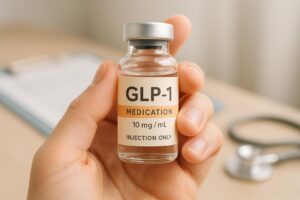When to Take GLP-1: A Comprehensive Guide to Timing Your Treatment

Introduction
Did you know that the timing of medication can significantly influence its effectiveness? In the realm of weight management and diabetes treatment, this concept is especially true for GLP-1 receptor agonists. These medications, which have gained immense popularity for their role in lowering blood sugar and promoting weight loss, require careful consideration regarding when to take them to maximize their benefits.
As we navigate the complexities of GLP-1 medications, it’s vital to understand not just what they do, but how and when to use them effectively. In this blog post, we will delve deep into the world of GLP-1 receptor agonists, exploring their mechanisms, benefits, potential side effects, and importantly, the optimal timing for their administration. By the end of this guide, you will have a clearer understanding of how to incorporate GLP-1 therapy into your weight management or diabetes care routine.
At TrimRx, we are dedicated to providing personalized weight loss solutions that prioritize your health and well-being. Our journey began with a vision to help individuals embrace healthier lifestyles by merging cutting-edge telehealth innovations with effective weight loss solutions. We believe in a compassionate, transparent approach to health, ensuring that every individual receives the care they deserve.
Now, let’s take a closer look at when to take GLP-1 medications and how they can play a pivotal role in your journey toward better health.
Understanding GLP-1 Receptor Agonists
What Are GLP-1 Receptor Agonists?
GLP-1 receptor agonists, or glucagon-like peptide-1 receptor agonists, are a class of medications designed to mimic the effects of the naturally occurring hormone GLP-1 in the body. This hormone is released in the intestines in response to food intake and plays a crucial role in regulating blood sugar levels and appetite.
By activating GLP-1 receptors, these medications help to:
- Stimulate insulin secretion: This occurs in response to meals, assisting in the management of blood glucose levels.
- Suppress glucagon secretion: Glucagon is a hormone that raises blood sugar levels; thus, its suppression helps to lower blood sugar levels.
- Slow gastric emptying: This leads to a feeling of fullness, reducing hunger and overall food intake.
Commonly Prescribed GLP-1 Medications
Several GLP-1 receptor agonists are currently available, each with unique features and dosing requirements. Some commonly prescribed options include:
- Semaglutide (Ozempic® for diabetes, Wegovy® for weight loss)
- Liraglutide (Victoza for diabetes, Saxenda for weight loss)
- Tirzepatide (Mounjaro® for diabetes, Zepbound® for weight loss)
Each of these medications has specific dosing schedules that may impact when you should take them.
When to Take GLP-1 Medications
General Guidelines for Timing
The timing of GLP-1 administration can vary depending on the specific medication and the individual’s treatment plan. Here are some general guidelines:
-
Daily Injections: For medications like liraglutide (Victoza) and oral semaglutide (Rybelsus), these are often taken once daily, usually before a meal. It is crucial to follow your healthcare provider’s instructions regarding the timing relative to meals.
-
Weekly Injections: Medications such as semaglutide (Ozempic) and tirzepatide (Mounjaro) are typically administered once a week. It’s best to choose a specific day of the week that works for your schedule, making it easier to remember your doses.
-
Oral Semaglutide: If you are taking Rybelsus (oral semaglutide), it is recommended to take the medication on an empty stomach, at least 30 minutes before eating, drinking, or taking any other medications. This helps optimize its absorption and effectiveness.
Factors Influencing Timing
Several factors can influence the optimal timing for taking GLP-1 medications:
-
Meal Timing: Since GLP-1 medications affect appetite and gastric emptying, taking them close to meal times can enhance their effectiveness. Ensuring that you take your medication as prescribed around meals can help manage your blood sugar levels more effectively.
-
Personal Schedule: Choose a time that fits seamlessly into your daily routine. Consistency is key to maintaining the efficacy of GLP-1 medications. If you are someone who travels frequently or has irregular meal patterns, planning your dosing schedule around these factors is essential.
-
Side Effects: Some individuals may experience gastrointestinal side effects, such as nausea or vomiting, especially when first starting GLP-1 therapy. Adjusting the timing of your medication to accommodate these effects may be beneficial. For instance, taking it during a time when you can rest afterward might help mitigate discomfort.
The Role of TrimRx in Your GLP-1 Journey
At TrimRx, we understand that navigating weight loss and diabetes treatment can be challenging. That’s why we offer a personalized assessment quiz to determine your eligibility for our prescription weight loss medications. By taking our free assessment quiz, you can receive a tailored treatment plan that aligns with your health goals.
As part of our commitment to your journey, we also offer quick-access supplements, such as GLP-1 Daily Support and Weight Loss Boost, which can complement your GLP-1 therapy and enhance your overall wellness. Our compassionate care approach ensures that you receive the support you need every step of the way.
Potential Benefits and Side Effects of GLP-1 Medications
Benefits
GLP-1 receptor agonists are associated with a variety of benefits beyond just blood sugar control and weight loss. Some of these benefits include:
-
Weight Management: Many individuals experience significant weight loss when using GLP-1 medications, which can be an essential aspect of managing obesity and related health conditions.
-
Cardiovascular Health: Studies suggest that GLP-1 medications may offer protective cardiovascular benefits, including reducing the risk of heart disease and stroke.
-
Improved Glycemic Control: These medications can help stabilize blood sugar levels, making them an effective addition to diabetes management strategies.
Side Effects
While GLP-1 medications offer numerous benefits, it is essential to be aware of potential side effects, which can include:
-
Gastrointestinal Issues: Common side effects include nausea, vomiting, diarrhea, and constipation. These side effects are often more pronounced when starting treatment or increasing the dosage.
-
Hypoglycemia: There is a risk of low blood sugar, especially when GLP-1 medications are combined with other blood sugar-lowering medications.
-
Injection Site Reactions: For injectable forms of GLP-1, some individuals may experience redness, swelling, or itching at the injection site.
It’s important to discuss any side effects you experience with your healthcare provider, as they can help you manage them effectively.
Optimizing Your GLP-1 Experience: Tips and Recommendations
Now that we have covered when to take GLP-1 medications and the various factors involved, let’s discuss some tips to optimize your experience with these treatments:
-
Stay Consistent: Choose a specific time for your medication and stick to it. Consistency helps maintain stable drug levels in your body, enhancing effectiveness.
-
Monitor Your Body’s Response: Keep track of how your body responds to the medication, including any side effects. This information can be valuable for discussions with your healthcare provider.
-
Communicate with Your Healthcare Provider: Regular check-ins with your healthcare provider are crucial. They can help you adjust your dosage, timing, and overall treatment plan based on your progress and any challenges you face.
-
Incorporate Lifestyle Changes: While GLP-1 medications can aid in weight loss and blood sugar management, combining them with healthy lifestyle changes—such as a balanced diet and regular exercise—will yield the best results.
-
Be Prepared for Missed Doses: Life can be unpredictable, and sometimes doses may be missed. Familiarize yourself with the protocol for missed doses to avoid any setbacks in your treatment.
Conclusion
In conclusion, understanding when to take GLP-1 medications is critical in maximizing their effectiveness for weight management and blood sugar control. By adhering to the recommended timings and considering individual factors, we can enhance our experience with these medications and achieve our health goals.
At TrimRx, we are committed to supporting your journey toward a healthier lifestyle through personalized care and innovative solutions. Remember, taking the first step is essential, and we are here to help you every step of the way.
If you’re curious about whether GLP-1 medications are right for you, consider taking our free assessment quiz.
Additionally, don’t forget to explore our quick-access supplements like GLP-1 Daily Support and Weight Loss Boost, which can further support your weight loss journey.
FAQ
Can I take GLP-1 medications if I am not diabetic?
Yes, certain GLP-1 medications are FDA approved specifically for weight management in individuals without diabetes. It’s important to consult with your healthcare provider to determine if these medications are suitable for you.
How long does it take for GLP-1 medications to start working?
The onset of action can vary by medication. While some may show effects within a week, others may take several weeks to reach their full effect. Always consult your provider for personalized information.
What should I do if I miss a dose of my GLP-1 medication?
If you miss a dose, take it as soon as you remember within a few days. If you realize it later, skip the missed dose and continue with your regular schedule. Do not take two doses in one week without consulting your healthcare provider.
Are there any long-term side effects associated with GLP-1 medications?
While GLP-1 medications are generally considered safe, long-term side effects are still being studied. It’s crucial to have regular check-ups with your healthcare provider to monitor your health while on these medications.
How can I ensure the best results from my GLP-1 therapy?
To ensure the best results, take the medication as prescribed, maintain a healthy diet and exercise routine, and communicate regularly with your healthcare provider about your progress and any side effects.
By fostering an understanding of GLP-1 medications and their proper use, we can empower ourselves to make informed decisions for our health. Together, we can embark on a successful weight loss journey that is both safe and effective.

Transforming Lives, One Step at a Time
Keep reading
GLP-1 Medication Side Effect Checker
Worried about GLP-1 medication side effects? Use our free checker for Semaglutide, Liraglutide, and more to learn what to expect and stay informed!
GLP-1 Dose Titration: Research Insights
Gradual GLP-1 dose increases balance weight loss and GI side effects; personalized titration and monitoring improve real-world outcomes.
Wave Life Sciences unveils Phase I results for obesity treatment
Wave Life Sciences’ single-dose RNA therapy showed 4% total body fat reduction and promising Phase I results.



